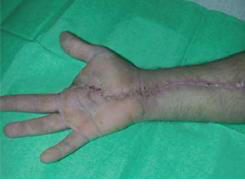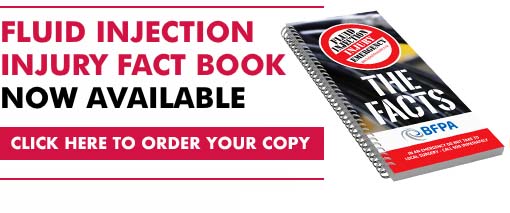Fluid Injection Injuries
Fluid Injection Injury “THE FACTS”
 This booklet supports the information covered within the BFPA Safety Foundation training course, and examines the factors that influence the background, symptoms, treatment and likelihood of fluid injection injuries – specifically identifying people who are most at risk and how such an injury should be treated. Fluid injection injuries, if not treated correctly, and quickly, can have a devastating effect, resulting in permanent loss of movement in limbs, and in some cases lead to amputation. Injection injuries can occur in many different applications, such as hydraulic and pneumatic systems, grease and paint guns, pressure washers etc.
This booklet supports the information covered within the BFPA Safety Foundation training course, and examines the factors that influence the background, symptoms, treatment and likelihood of fluid injection injuries – specifically identifying people who are most at risk and how such an injury should be treated. Fluid injection injuries, if not treated correctly, and quickly, can have a devastating effect, resulting in permanent loss of movement in limbs, and in some cases lead to amputation. Injection injuries can occur in many different applications, such as hydraulic and pneumatic systems, grease and paint guns, pressure washers etc.
Fluid Injection Injuries have been known to occur at pressures as low as 6.9 bar (100 psi) which means the people most at risk are not just limited to those who work within the mobile replacement hose business, but anyone who works with equipment under pressure albeit hydraulic or pneumatic etc.
Fluid Injection Injury Emergency Fact Book Contents:
ACCIDENT MANAGEMENT
- Procedure and Process Flow – How to Treat a Fluid Injection Injury
- Treatment
- Suggested guidelines for optimal treatment (for the medical professional)
- Site of Injection
- Injection Injury Patient Information Sheet
- What to look out for: Step by step progression of high pressure injections
RISK MANAGEMENT STRATEGIES
- Abstract
- Introduction
- The People Most at Risk
- The Material Injected, Site of Injection and Likelihood of Amputation
- Identifying the symptoms
- Outcome
- Conclusion
- The Position of the BFPA





















